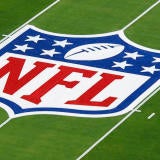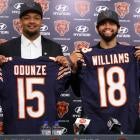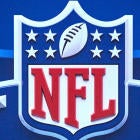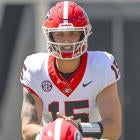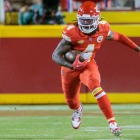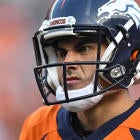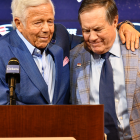Before tragically tearing his ACL at practice in early November, Texans rookie quarterback Deshaun Watson held a sizable advantage in the Offensive Rookie of the Year race and even began to enter the MVP conversation. That's what makes it so surprising to see Watson get beat out by another rookie quarterback in another race, albeit a far less prestigious one.
On Wednesday, Pro Football Focus -- a website that evaluates and grades NFL players while also tracking advanced statistics -- revealed their overall grades for the 2017 rookie quarterback class. Shockingly, it wasn't Watson who topped the list. It was Mitchell Trubisky, the No. 2 pick of the Bears, who barely edged Watson. C.J. Beathard, who started for the 49ers before Jimmy Garoppolo arrived in San Francisco, and Browns quarterback DeShone Kizer rounded out the list.
Overall grades for the rookie QBs in 2017! pic.twitter.com/En4o0YfAhT
— Pro Football Focus (@PFF) February 14, 2018
You've probably heard of PFF by now. NBC analyst Cris Collinsworth is the majority owner and as a result, their numbers frequently appear onscreen during "Sunday Night Football." An unknown number of teams -- in January 2015, the number was at 13 -- have hired PFF as a client. Three years ago, Jenny Vrentas explained their role in a story for Sports Illustrated:
Pro Football Focus will meet virtually any of its clients' requests, such as measuring hang time to two decimal points for punts and kickoffs, and tracking which direction a center turns after the snap as a potential indicator of which offensive guard is the weaker link. PFF has also created a computer program that diagrammed each of the 32,779 regular-season plays from the line of scrimmage in 2014, depicting details like wide receiver splits, depth of players off the line, motions, and route combinations. That information is then linked to a team's video system so coaches can put eyes on what the numbers are telling them.
That doesn't mean their grades are perfect. It doesn't mean they're the definitive source for player rankings. But they're a legitimate tool -- one of many -- when it comes to player evaluation and advanced statistics. All of which is to say that their controversial grade above shouldn't be immediately dismissed.
Here's why it's not entirely insane: Look at the sample sizes. Watson played in seven games. Trubisky played in 12. PFF's Steve Palazzolo pointed out on Twitter that if Watson hadn't played in relief of Tom Savage in Week 1, his grade wouldn't have dropped as low as it did. In that game, Watson completed 52.2 percent of his passes for 102 yards, one touchdown, one pick, and a 60.4 passer rating.
Take out Watson's first game in relief vs Jags and he's much higher. That's the biggest reason
— Steve Palazzolo (@PFF_Steve) February 14, 2018
The overall raw statistics give the edge to Watson, who scored 21 touchdowns (19 passing, two rushing), threw eight interceptions, averaged 8.3 yards per attempt, and posted a 103.0 passer rating. Trubisky, meanwhile, scored nine touchdowns (seven passing, two rushing), threw seven interceptions, averaged 6.6 yards per attempt, and posted a 77.5 passer rating. It's not even a close race in that regard. Watson outproduced Trubisky in fewer games.
But as always, it's more complicated than the raw statistics. Watson threw to All-Universe receiver DeAndre Hopkins and home-run hitter Will Fuller. Trubisky's top receivers were Kendall Wright and Dontrelle Inman. Watson's coach is a supposed quarterback guru in Bill O'Brien. Trubisky's coach was John Fox. Advantage: Watson.
Look, both the Bears and the Texans should be hopeful for better futures because of their young quarterbacks. Both players demonstrated that they have the skill set that's needed to thrive in the NFL.
The best play of Mitch Trubisky’s young career. Not sure how many QBs make this play. pic.twitter.com/XXqx0thKmH
— Sean Wagner-McGough (@seanjwagner) October 16, 2017
.@deshaunwatson goes DEEEEEP.
— NFL (@NFL) October 29, 2017
And @Will_Fuller7 gets behind the LOB for SIX. #Texanspic.twitter.com/vDFvZPVeiG
Both players also have question marks heading into their second seasons. Watson's question marks are more related to his health than ability to play football, considering he's now torn both of his ACLs in a span of three years, while Trubisky's are related to his ability to translate his raw skills to the field so that his output matches his potential. Trubisky will also have to learn a new offense under new coach Matt Nagy.
The bottom line is that both quarterbacks project to have bright futures, which is good for the league. With all-time great quarterbacks like Tom Brady, Drew Brees, and Aaron Rodgers getting up there in age, the NFL is in need of a future generation of top-flight quarterbacks. From Carson Wentz and Jared Goff to Trubisky and Watson, the future is already here.









